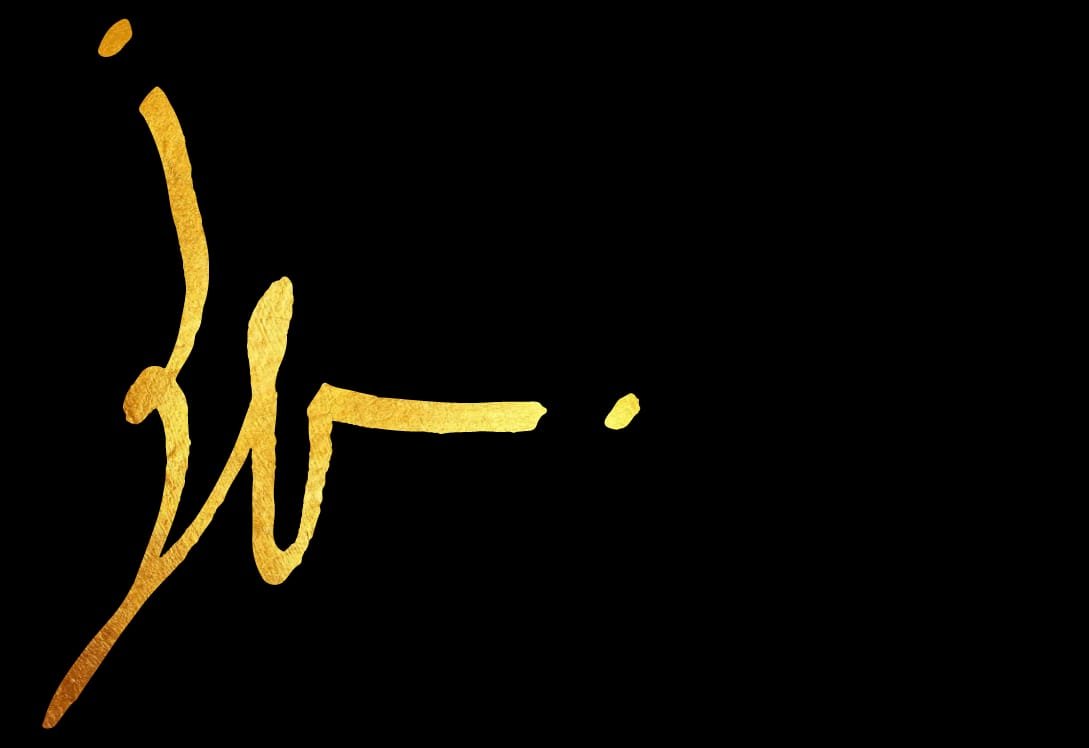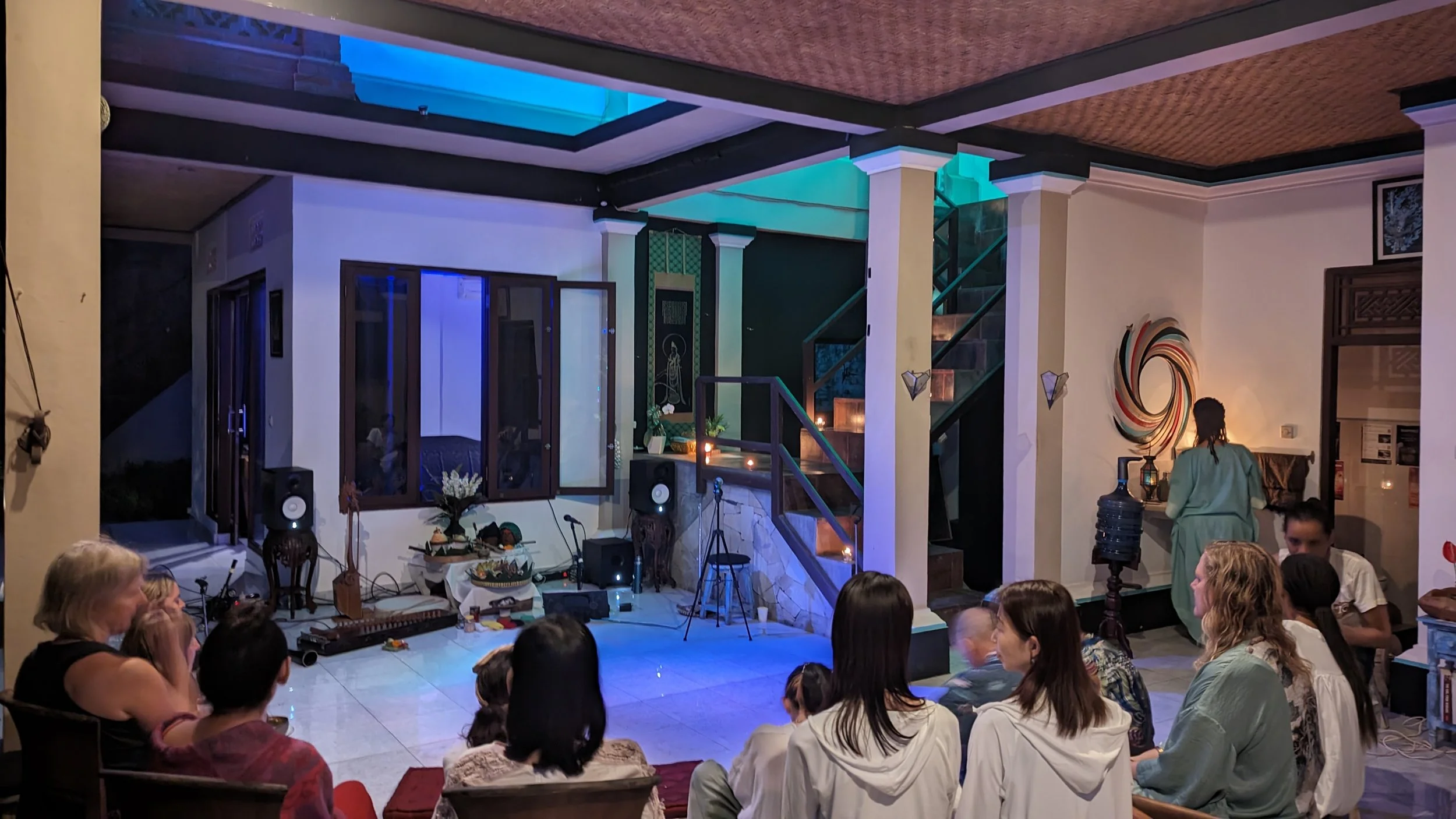
Tuluvi Arts
…
Tuluvi Arts are creative practices emerging from an awareness of multidimensional nature and experience. They represent unique vibrational signatures and cosmic lineage, embodying principles of Oneness and individuality; connecting the physical and metaphysical realms. Emerging through deep meditative practice, Tuluvi Arts serve as a bridge between universal energies and human creativity, offering insights into both personal and collective truths. The creativity expressed is internally directed, from an expansive source -mysterious and abstract, yet grounded and connected- taking human form in ancient-future wisdom, intercultural collages and refined naturalism.
Kamau Abayomi and Nanaka Abayomi
What is Tuluvi?
Tu-Lu-Vi is a vibratory field — an intelligent frequency that emerged through deep meditative and mantra practice, yet transcending the boundaries of any single tradition or system. It is a living current — an energetic presence that reveals itself through the subtleties in creative expressions.
At its core, Tuluvi carries the paradox of Oneness and Individuality — a resonance that simultaneously grounds and expands. When intoned, at lower frequencies, Tuluvi feels warm, rooted, and expansive — deeply connected to the Earth’s stabilizing energies. When chanted at higher frequencies, it evokes a cooler, cosmic quality; activating the crown and upper centers without severing the grounding below. This dynamic interplay evokes a heightened state of equanimity, where presence is refined and perception widens.
Tuluvi communicates itself through symbols — not as static sigils, but as energetic transmissions encoded with vibratory meaning. Each symbol -expressed in written, spoken or movement- carries its own essence, yet collectively they form a language of vibration; a visual expression of multi-dimensional awareness. This language holds no fixed meaning; instead, it reveals personal and universal truths to those who engage with patience and presence. Tuluvi’s art is inherently Asemystic — a state in which meaning emerges not from deciphering, but from entering a state of attunement, where consciousness and the symbol converge.
Rooted in the understanding that spiritual development and creativity are inseparable, Tuluvi invites participants to awaken their capacity to perceive reality beyond surface appearances. It aligns with the wisdom of traditional cultures that revered art, movement, and sound as sacred pathways to expanded consciousness.
To engage with Tuluvi is to step into a field of inner discovery, where self-knowledge unfolds through direct experience. Whether through chanting its tones, exploring its symbols, or practicing its energetic principles, Tuluvi reveals itself as a dynamic, living current — one that evolves as the individual opens themselves to it.
Tuluvi is not a system to master — it is a resonance to embody. It thrives in the space between knowing and not knowing, in the quiet recognition that presence itself is the greatest portal to truth.
Gods Playing Human (Full Film Here)

Origins and Discovery
The emergence of Tuluvi was not the result of intellectual pursuit, but rather the unfolding of an inner resonance — a spontaneous revelation born from deep spiritual practice. Its discovery came through a profound engagement with the mantra "Aham Brahmasmi" — the ancient Vedantic declaration meaning "I am the universe" or "I am Brahman."
After completing an extended cycle of chanting "Aham Brahmasmi" — with repetition carried out 57,000 times —I continued chanting into the next cycle, when something remarkable occurred. Without conscious volition, the intonation shifted, as if guided by an intelligence beyond the conscious mind. The chant evolved into the syllables "Tu," "Lu," and "Vi." These sounds emerged not as random utterances, but with a distinct vibratory presence — each tone carrying its own energetic quality yet woven into a singular current.
In the moment of its arrival, Tuluvi was not perceived as a word to be understood but as a frequency signature — a vibrational key that activated a heightened state of awareness and expanded perception. The experience carried a sense of recognition — as though Tuluvi was not being created, but remembered.
This tonal emergence marked the beginning of an ongoing revelation. Following the experience, I found myself entering deeper states of meditation where spontaneous creative impulses would arise. Upon returning from these meditative states, I began drawing intricate symbols — not consciously designed, but seemingly transmitted through the resonance of Tuluvi. These symbols carried a potency that transcended language, and their presence felt both personal and universal — as if they belonged to something timeless yet deeply intimate.
As this symbolic language grew, I experienced an unfolding awareness that Tuluvi was not confined to the mind — it existed as a field of resonance, one that held connections to a cosmic lineage. Through direct experience, I recognized Tuluvi’s link to higher-dimensional planes.
As this was unfolding, my inquiring mind desired more direct knowledge of what Tuluvi was, and so I consulted two oracles, the Metu Neter and the I Ching. The Metu Neter, an oracle rooted in ancient Egyptian cosmological wisdom, returned an answer of ‘Sheps Hetep’, a card representing the highest expression of The Ancestors. The I Ching gave me the hexagram number 48, ‘The Well’ moving into number 52, ‘The Gentle Penetrating Wind’. With these readings, my logical mind was given further confirmation of this as an intimate connection beyond 3rd dimensional expression.
As the symbolic language continued to flow onto the pages of my notebook, after my meditations, I became curious as to what would happen if I explored this process with canvas and colored markers and then paint and brushes.
Meditation, create… meditation, create… meditation, create…
This process would continue for almost a year. The works culminated in an exhibition, which I entitled ‘Evaporate Until Infinite’
About us
Peace and blessings, we are Kamau and Nanaka Abayomi. Four years ago we met at a dance event in Ubud, Bali, Indonesia. As Lovers of, and professionals in music, dance and the arts, we immediately connected and began hanging out for lunch and good chats. It was during the pandemic times, and Bali had just ended lock-down and opened back up. Kamau had already been living and teaching arts in Bali for 17 years, while Nana for just a year, having gotten stuck when Bali locked down.
One day we were discussing an ideal home we would love to live in (not together, but just for ourselves). As multidisciplinary artists, we both expressed a desire to live in an intimate space, but spacious enough to allow for doing multiple creative arts work, teach classes, build community and cultivate a peaceful garden. Little did we know that about two weeks later we would be shown an available house which perfectly fit our visions, and decide to move in together; having only known each other for a little over a month. One year later after living and creating together, we got married in this house and have been grateful to be able to naturally manifest our vision.
Explore our courses and membership
Contribute to the Movement
✩
Contribute to the Movement ✩
Join our movement to expand our intimate art house in Bali where spirituality, art, nature, technology and intercultural communities unite
Tuluvi Art House: Bridging Communities Through Art & Spirituality
We asking for your assistance in bringing the stability and expansion of our sacred, and intimate space in Bali. We are seeking contributions to keep our space and continue serving as a hub for immersive performances, community classes, artist residencies, spiritual development workshops, exhibitions and more. Tuluvi Art House is a space where intercultural visionary art, soulful exploration and spiritual growth and thrive together. The success of this campaign here in Bali will provide a template for Tuluvi Art House to be established in Japan in the future.




































What Your Contribution Does
Our Funding Goal is to raise $50,000. With this we be able to:
1. Expand our vision to inspire the creation of new creative projects that explore spiritual growth, holistic development, intercultural connections, and ethically centered artistic expression. Through supportive technology, we will offer artists the tools to create immersive, transformative experiences.
2. Secure the lease on our space for the next five years, preserving our home, supporting our Balinese family, and protecting the cultural heart of Ubud from further, excessive gentrification.
3. Renovate and redesign the house into a safe, high-quality sacred space — a unique art house that uplifts the village by offering a welcoming hub for creative exchange, spiritual connection and education.
4. Offer meaningful opportunities to young and underrepresented local artists and practitioners through a dedicated apprenticeship program. This nurturing environment will value depth, positive intention, creative freedom, and community uplift.
5. Integrate transformative technology — including immersive installations, projection mapping, and interactive experiences — creating a participatory journey that bridges the ancient and the future, offering new ways for audiences to engage with spiritual arts.
Go to our IndieGogo Campaign Page for full details: Here
Why give?
To give is to recognize the unseen thread that connects us — a thread woven by something far deeper than we often realize. When you give, you step into that flow, becoming part of a quiet unfolding — one that carries meaning far beyond what we can immediately see.
Giving is an act of trust — a gesture that says you believe in something enough to support its growth. It’s a way of placing a seed into fertile ground, trusting that what blooms will carry light, beauty, clarity and purpose.
To give to the Tuluvi Art House is to contribute to a movement to awaken, inspire, and connect. It’s not just a venue — it’s a living sanctuary where art, creativity, and spirit converge. It’s a space where artists will translate unseen truths into form, where seekers will discover insights beyond words, and where technology will be woven with intention to deepen the experience of presence.
Giving is not just support — it’s participation. It’s a way of saying, “I see the value in creating something that invites people into deeper connection — with themselves, with each other, and with the creative force that moves through us all.”
Give, because what you offer today can inspire moments of insight, healing, and transformation that ripple far beyond what you can imagine.




















